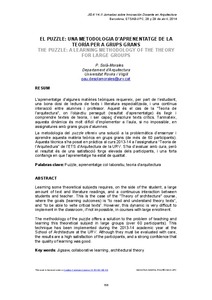Mostra el registre d'ítem simple
El puzzle: una metodologia d’aprenentatge de la teoria per a grups grans
| dc.contributor.author | Solà-Morales Serra, Pau de |
| dc.contributor.editor | Garcia Escudero, Daniel |
| dc.contributor.editor | Bardí Milà, Berta |
| dc.date.accessioned | 2014-05-16T17:57:25Z |
| dc.date.available | 2014-05-16T17:57:25Z |
| dc.date.issued | 2014-04 |
| dc.identifier.citation | Solà-Morales, Pau de. El puzzle: una metodologia d’aprenentatge de la teoria per a grups grans. A: Garcia Escudero, Daniel; Bardí Milà, Berta, eds. "II Jornadas sobre Innovación Docente en Arquitectura (JIDA'14), Escuela Técnica Superior de Arquitectura de Barcelona, 28 y 29 de Abril de 2014". Barcelona: UPC IDP; GILDA, 2014. ISBN: 978-84-9880-594-9, p. 156-164 |
| dc.identifier.isbn | 978-84-9880-594-9 |
| dc.identifier.issn | 2462-571X |
| dc.identifier.uri | http://hdl.handle.net/2099/14618 |
| dc.description.abstract | L'aprenentatge d'algunes matèries teòriques requereix, per part de l’estudiant, una bona dosi de lectura de texts i literatura especialitzada, i una contínua interacció entre alumnes i professor. Aquest és el cas de la "Teoria de l'arquitectura", on l'objectiu perseguit (resultat d’aprenentatge) és llegir i comprendre textes de teoria, i ser capaç d’escriure texts crítics. Tanmateix, aquesta dinàmica és molt difícil d’implementar a l’aula, si no impossible, en assignatures amb grans grups d’alumnes. La metodologia del puzzle ofereix una solució a la problemàtica d’ensenyar i aprendre aquesta matèria teòrica en grups grans (de més de 60 participants). Aquesta tècnica s’ha posat en pràctica al curs 2013-14 a l’assignatura “Teoria de l’Arquitectura” de l’ETS d’Arquitectura de la URV. S’ha d’avaluar amb cura, però el resultat és de una satisfacció força elevada dels participants, i una forta confiança en que l’aprenentatge ha estat de qualitat. |
| dc.description.abstract | Learning some theoretical subjects requires, on the side of the student, a large amount of text and literature readings, and a continuous interaction between students and teacher. This is the case of the "Theory of architecture" course, where the goals (learning outcomes) is “to read and understand theory texts”, and “to be able to write critical texts”. However, this dynamic is very difficult to implement in the classroom, if not impossible, in courses with large enrollment. The methodology of the puzzle offers a solution to the problem of teaching and learning this theoretical subject in large groups (over 60 participants). This technique has been implemented during the 2013-14 academic year at the School of Architecture at the URV. Although they must be evaluated with care, the results are a high satisfaction of the participants, and a strong confidence that the quality of learning was good. |
| dc.format.extent | 9 p. |
| dc.language.iso | cat |
| dc.publisher | Grup per a la Innovació i la Logística Docent en l'Arquitectura (GILDA) |
| dc.publisher | Universitat Politècnica de Catalunya. Iniciativa Digital Politècnica |
| dc.relation.ispartof | Jornadas sobre Innovación Docente en Arquitectura (2as: 2014: Barcelona) |
| dc.rights | Attribution-NonCommercial-NoDerivatives 4.0 International |
| dc.rights.uri | https://creativecommons.org/licenses/by-nc-nd/4.0/ |
| dc.subject | Àrees temàtiques de la UPC::Arquitectura |
| dc.subject | Àrees temàtiques de la UPC::Ensenyament i aprenentatge::Ensenyament universitari |
| dc.subject.lcsh | Architecture -- Study and teaching (Higher) |
| dc.subject.lcsh | Work groups |
| dc.subject.other | Puzzle |
| dc.subject.other | Aprenentatge col·laboratiu |
| dc.subject.other | Teoria d’arquitectura |
| dc.subject.other | Jigsaw |
| dc.subject.other | Collaborative learning |
| dc.subject.other | Architectural theory |
| dc.title | El puzzle: una metodologia d’aprenentatge de la teoria per a grups grans |
| dc.title.alternative | The puzzle: a learning methodology of the theory for large groups |
| dc.type | Conference report |
| dc.subject.lemac | Arquitectura -- Ensenyament universitari |
| dc.subject.lemac | Treball en equip |
| dc.identifier.doi | 10.5821/jida.2014.5030 |
| dc.identifier.dl | B 9090-2014 |
| dc.description.peerreviewed | Peer Reviewed |
| dc.rights.access | Open Access |
| dc.relation.references | Aronson, E., Blaney, N., Stephin, C., Sikes, J., & Snapp, M. The jigsaw classroom. Beverly Hills, CA : Sage Publishing Company, 1978. |
| dc.relation.references | Ibarra Sáiz, María Soledad, Rodríguez Gómez, Gregorio y Gómez Ruiz, Miguel Ángel. La evaluación entre iguales: beneficios y estrategias para su práctica en la universidad. Revista de Educación. 2012, 359. Septiembre- diciembre. |
| local.citation.author | Solà-Morales, Pau de |
| local.citation.contributor | Jornadas sobre Innovación Docente en Arquitectura (JIDA) |
| local.citation.pubplace | Barcelona |
| local.citation.publicationName | II Jornadas sobre Innovación Docente en Arquitectura (JIDA’14), Escuela Técnica Superior de Arquitectura de Barcelona, 28 y 29 de Abril de 2014 |
| local.citation.startingPage | 156 |
| local.citation.endingPage | 164 |
| local.ordre | 15 |
| local.personalitzacitacio | true |


